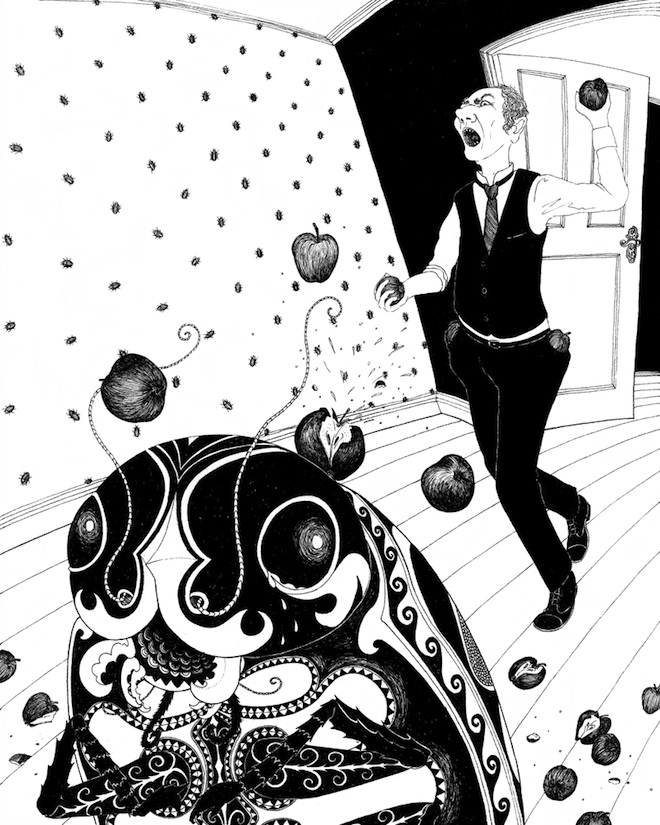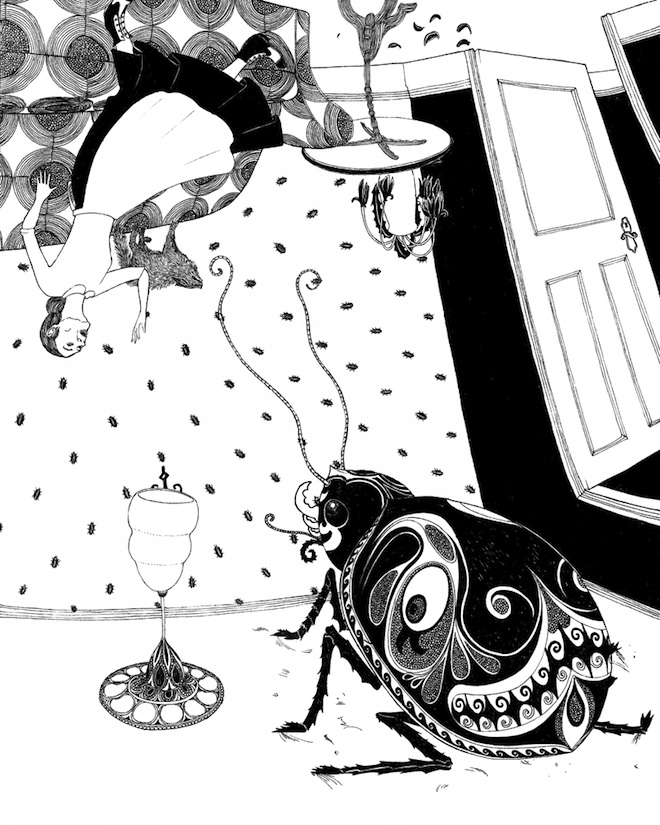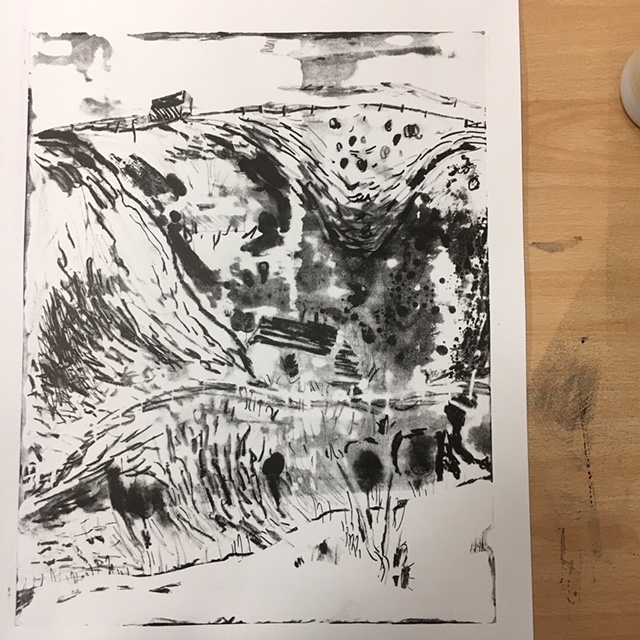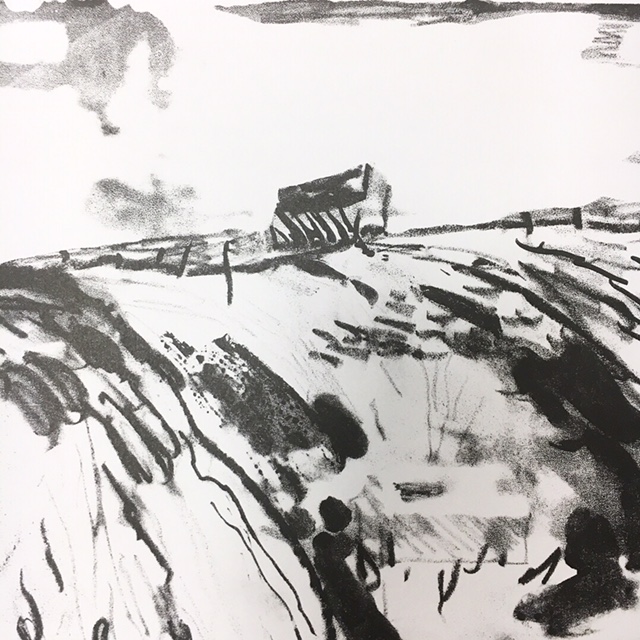12/01/18
On our first day as a group we traveled to Cuckmere Haven, in the bus there we were told about how the landscape is changing and that the cliff face disintegrates by half a meter each year we were warned not to go to close to it. While at Cuckmere we began a group walk across the hills, taking photos as we went as we got further up the steep hill the landscape became more interesting and revealed itself to us. We sat and drew together for a while, this was fairly successful I drew fragments of the landscape not feeling confident enough to go further. It was also very windy which was off putting.
We walked further into the landscape towards the beach, it was calmer down there and less windy, I tried to illustrate this in my drawing from this scene. I drew the scene in coloured pastel, I was proud of this drawing as it had a sense of the landscape to it and I felt happy with the effect of the pastels, as they aren’t one of my favourite medias to use.
Next, we went down to the beach here I collected a piece of sponge, a prickly plant and sheep wool. I also noted that surrounding the beach were full bin bags and assorted pieces of man made material – this reminded me of my idea for the Manifesto project, and how the environment is changing due to waste and global warming.
After going to the beach, we finished the trip with a hot chocolate. When we got back we talked through our drawings. I hadn’t created that many which disappointed me, however, I got plenty of photos and collected a few things to work from.
Below is a PDF of the photos that I took while at Cuckmere Haven, I was drawn to the landscape appearing to have layers and the sheep. Also I was looking for different textures in the landscape; the grass against the water and how to illustrate that successfully.
Photographs of Cuckmere Haven
Cuckmere haven photos.compressed-1kkw2bb
13/01/18
The next day we looked into how to use materials differently and had a short introduction into how to use ink successfully, as this is one of the areas Emma Stibbon works in. We cut the feathers we had found into quills and the sticks into drawing implements.
Emma made an interesting comment that using implements from the landscape to make a drawing of a landscape is a good way to make the drawing different and location specific.
I collected a lot of wool from the day as I have always been interested in textiles. I’m eager to look into how to use it in my work.
In the afternoon, I was in my module option Lithography. In that we were learning how to make marks on the zinc plate, I took it as a good opportunity to create a new landscape drawing. I made a response to the coloured pastel drawing I made and it came out really nicely. I am looking forward to trying to recreate some of the marks I used in it.
Sketchbook Work

Above is a sketchbook page utilising ink and water to recreate a similar atmosphere to what I felt in Cuckmere.
14/01/18
Below are my notes from a talk with Emma Stibbon, in which she looked at different types of landscape artists from traditional to contemporary and also discussed her own practice and where it has led her. I was most interested in Emma talking about enjoying landscapes which have a sense of transforming, in modern times most of our landscapes are changing before are very eyes. With the impact of global warming the environment is constantly evolving for better or worse and through illustrating this we are documenting these changes. This felt relevant to my current Manifesto project.
Emma Stibbon talk notes

15/01/18
We had an initial crit with Emma where we shared our ideas and discussed how to make them a reality, I was a little behind at this point but felt confident that I could finish that day.
Planning for a concertina book
I decided that I wanted to create a concertina book. To help with planning this I made three example books (in portfolio), I consulted with Emma on what form she liked the most. She gave me a new idea to create a concertina book which could present the images in a landscape format like my photos, this presented a challenge in the folding of the book. However, I made a successful practice model and continued designing.
Below are photos from the planning of my concertina book, I stuck up the photos on the wall knowing that I had to create at least 8 pages for my book. As part of my process I tried to find something which could run throughout the book like a line or form. So I found focal points and adjoining lines that I could follow through the book (as shown below). In the overall crit of the project it was commented on that this worked really well and made the images work individually and complete.



Using my lithograph
While completing my concertina book I had an issue with keeping the landscape interesting. I originally decided to make them all in ink and water washes with ink details, however, this became repetitive. So I looked into how I could use my lithograph to collage with and create some different mark making.
Below are some examples of the different textures I obtained from my lithograph, interestingly these are actually marks made when I made my first lithograph wrongly. I had applied the ink while the zinc plate had dried, which is a huge no in lithography. However, I really enjoyed the effect it created and it was one of my favourite parts of the image, it created a bubbling look which wasn’t expected.
Final Crit
The final crit of the project went well and it was really interesting to see how everybody had differently responded to the same landscape.
I completed my concertina book with drawings of 8 landscapes, using ink, water, pencil, charcoal and chalk. I decided to use many medias as it added variety to the landscapes. I think the concertina style book was a good choice of outcome, and Emma remarked that when composed in a + shape it could be compared to North, South, East and West. I’m really happy with the landscapes and was told that I knew when to hold back and stop, which kept the simplicity of the landscapes.
Lithography outcome





























